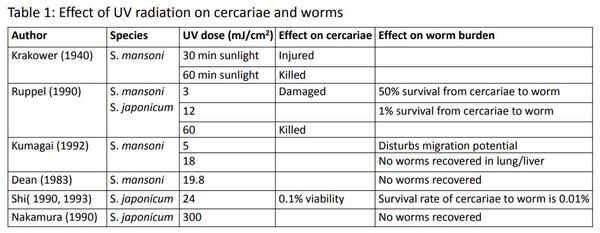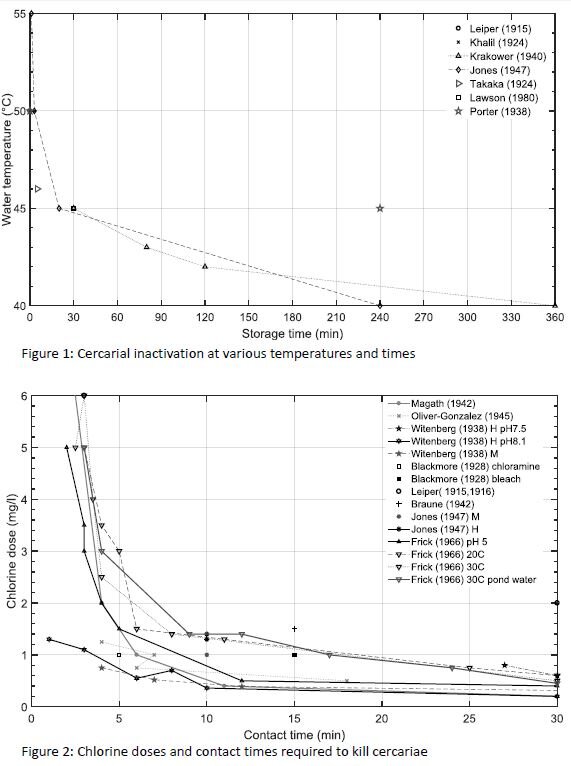ASTMH 2017 Poster - Water treatment for the removal of schistosome cercariae: a review and identification of research needs
This article is adapted from a poster presented at ASTMH 2017 by Laura Braun and Dr. Michael Templeton.
Introduction
Schistosomiasis is a water-borne helminthic disease caused by parasitic worms. Infection occurs through contact with cercariae-infested freshwater. While treatment with praziquantel can have immediate beneficial effects, reinfection can occur rapidly if people are re-exposed to contaminated water.
Water treatment for schistosomiasis control seeks to eliminate viable cercariae from water, and hence cut schistosomiasis transmission.
Objective
Determine the effectiveness of water treatment processes at removing or inactivating schistosome cercariae in water as reported in the literature, and identify important gaps in knowledge.
Systematic Review Methodology
Searched four databases for any combination of water treatment and human schistosome cercariae search terms
• Web of Science, PubMed, British Library, GoogleScholar
• Found 1100 studies from 1910 to present.
• Worked through studies according to flowchart on right
• 67 studies about the effect of water treatment on human schistosome cercariae
Systematic Review and Results
The studies were categorized into 5 groups, according to the water treatment process. The results are summarized below for each treatment method:
- Storage: Cercariae can live up to 3 days in natural conditions, but survival is heavily dependent on temperature.
- Temperature: Cercarial lifespan decreases exponentially with temperature. This is due to thermal intolerance and energy depletion. Cercariae move faster at higher temperature, and hence deplete energy faster. Cercariae die instantly at temperatures exceeding 55°C.
- Chlorination: Effect of chlorine increases exponentially with chlorine dose. Doses above 1.5 mg/l inactivate cercariae within 10 minutes. However, results are highly variable at lower chlorine doses and shorter inactivation times. The pH and temperature of studies was often not recorded, nor was the residual chlorine, making it difficult to assess the real effect of chlorination on cercariae.
- Filtration: Studies were contradicting, and results heavily dependent on bed depth. Sand filtration with <0.30mm sand grains may be effective at filtering cercariae.
- Ultraviolet disinfection: UV doses as low as 3 mJ/cm2 have been shown to damage cercariae. This damage can affect later life stages; schistosoma have reduced migration potential, and schistosomes can become sterile. UV doses above 60 mJ/cm2 have been shown to kill cercariae. Solar disinfection may be effective in killing cercariae. Many studies lack exact UV measurements.
Gaps in Knowledge
- Different methods are used to assess the effect of water treatment on cercariae (motility, infectivity or viability of cercariae), making it difficult to compare results.
- Lack in studies on S. japonicum and S. haematobium.
- Experiments should be conducted using natural water in addition to pure water, as the real water matrix constituent may affect the efficiency of water treatment processes.
- Chlorination: Studies conducted under controlled pH and temperature are needed. Many studies exclusively measured the chlorine dose, not the residual chlorine which is essential for calculating the CT value.
- Filtration: The effect of sand grain size, bed depth and flow rate on cercariae filtration should be evaluated.
- UV: Many studies lacked accurate UV measurements, and did not control temperature (heat emitted by UV lamps can affect experiments). The effectiveness of solar disinfection needs to be further examined.
Acknowledgments: Dr. Jack Grimes for his guidance, and Merck, the Engineering and Physical Sciences Research Council (EPSRC), and the Centre for Doctoral Training in Sustainable Civil Engineering for their financial support. This research is also supported by EPSRC project EP/P028519/1. For more information please visit www.wiserschisto.com
Download the presentation (PDF)
References
- Blackmore, H. (1928). Preliminary Note on the Sterilization of Bilharzia-Infected Water. Journal of the Royal Army Medical Corps, 51(4), 262-264.
- Braune, J. (1942). Ueber die Verhuetung der Bilharziose unter Feldzugsbedingunge, insbesondere ueber die Gewinnung von zerkarienfreiem Wash- und badewasser. Deutsche
- Tropenmedizinische Zeitschrift, 46(16).
- Dean et al.(1983). Immunization of mice with ultraviolet-irradiated Schistosoma mansoni cercariae: a re-evaluation. Am J Trop Med Hyg, 32(4), 790-793.
- Frick, (1966). The Influence of pH and Temperature on the Cercaricidal Activity of Chlorine. Military Medicine, 131(4).
- Jones et al. (1947). Effects of water treatment processes on schistosome cercariae. Bull Natl Inst Health, 2(189), 109-130.
- Kawata, K. (1982). Slow sand filtration for cercarial control in North Cameroon village water supply. Water Science and Technology, 14(6-7), 491-498.
- Khalil, A. (1924). Ankylostomiasis and bilharziasis in Egypt: The control of bilharziasis in Egypt. Retrieved from Cairo:
- Krakower, C. A. (1940). Some Observations of the Effects of Physical and Chemical Agents on the Cercariae of Schistosoma mansoni. Puerto Rico Journal of Public Health and Tropical Medicine, 16(1), 26-44 pp.
- Kumagai et al. (1992). Migration Kinetics of Ultraviolet-attenuated Schistosoma mansoni in ICR Mice. Japanese Journal of Parasitology, 41(4), 300-305.
- Lawson, J. R. W., R. A. (1980). The survival of the cercariae of Schistosoma mansoni in relation to water temperature and glycogen utilization. Parasitology, 81(2), 337-348.
- Leiper, R. T. (1915). Report on the results of the bilharzia mission in Egypt. Journal of the Royal Army Medical Corps, 25(1).
- Magath, T. (1942). Lethal Dose of Chlorine for Cercariae of Schistosoma mansoni. Naval Medical Bulletin, 40(1).
- Nakamura et al. (1990). Monoclonal antibodies against UV attenuated cercariae of S. japonicum. Production and their effect on protective immunity. JAP. J. PARASITOL, 39(6).
- Oliver González et al. (1945). The Effect of Chlorine on the Motility and Infectivity of the Cercariae of S.mansoni. Puerto Rico J. Pub. Health & Trop, Med., 20(3).
- Porter, A. (1938). The Larval Trematoda Found in Certain South African Mollusca with Special Reference to Schistosomiasis (Vol. 8): South African Institute for Medical Research.
- Ruppel et al. (1990). S. mansoni and S. japonicum: comparison of levels of ultraviolet irradiation for vaccination of mice with cercariae. Parasitology, 101 Pt 1, 23-26.
- Shi et al. (1990). Schistosoma japonicum: An ultraviolet-attenuated cercarial vaccine applicable in the field for water buffaloes. Experimental Parasitology, 71(1), 100-106.
- Takaka, S. (1924). On the Thermal Resistance of the Cercaria of S. japonicum and also on the Infection by Bathing in Warm Water. Tokyo Iji-Shinshi Tokyo Medical News(2393).
- Witenberg and Yofe. (1938). Investigation on the purification of water with respect to schistosome cercariae. Transactions of the Royal Society of Tropical Medicine and Hygiene, 31(5).

